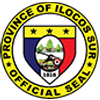FROM “SAMTOY” TO “ENCOMIENDA DE YLOKOS”
Prior to the arrival of the Spaniards, the entire coastal plains in Northwestern Luzon stretching from 18° 30’ 45.74” North longitude, 120° 44’ 5.85” East latitude at Bangui, Ilocos Norte to 16° 50’ 39.50 North longitude, 120° 22’ 34.99” East latitude Namacpacan, Luna, La Union in the South, bore an ancient name called “SAMTOY” a contraction from “SAO MI DITOY” – Ilokano words that means “OUR DIALECT”.
The Spaniards later called the entire region “YLOKOS” from the Spanish words “Y-looc” that mean “From the coves”, or coastal bays, where the coastal inhabitants built their villages along “the “Look”. The Spaniards’ continuous reference to these coastal villages as “Yloocos” became contracted to Ylocos”, that mean literally “from the lowland coves”. The Spaniards ultimately referred to the inhabitants “dwellers of the lowland coves” as “Yloocanos” now spelled as “Ilocanos”.
The Y-LOCOS, “Y-Lokos, contracted by constant pronounciation into “YLOCOS” or “ILOCOS” today and its people – Ylocanos” and now “Ilocanos!” Region was already a thriving, fairly advanced cluster of towns and settlements familiar to Chinese, Japanese and Malay traders when the Spaniard explorer Don Juan de Salcedo and members of his expedition arrived in Vigan on June 13, 1572. Forthwith, they made Cabigbigaan (Bigan), the heart of the Ylocos settlement, their headquarters-which Salcedo called “Villa Fernandina” and eventually gained fame as the “Intramuros of Ilocandia”. Salcedo declared the whole Northern Luzon as an “encomienda.” Subsequently, he became the encomendero of Vigan and Lieutenant Governor of the Ylokos until his death.
THROUGH THE CROSS AND THE SWORD: NUEVA SEGOVIA
Augustinian missionaries joined the military forces in conquering the region through evangelization. They established parishes and built churches that still stand today. Three centuries later, Vigan became the seat of the Archdiocese of Nueva Segovia. Today Vigan City houses the Immaculate Conception School of Theology – sustaining the Catholic faith and evangelization of Ilocandia.
INTO ILOCOS TWINS
A royal decree of February 2, 1818 separated Ilocos Norte from Ilocos Sur, the latter to include the northern part of La Union (as far as Namacpacan, now Luna) and all of what is now the province of Abra. The sub-provinces of Lepanto and Amburayan in Mt.Province were annexed to Ilocos Sur. The passage of Act 2683 by the Philippine Legislature in March 1917 defined the present geographical boundary of the province.
SEAT OF TWO WORLD HERITAGE SITES
Ilocos Sur has two congressional districts with two (2) component cities, thirty two (32) municipalities and seven hundred and sixty eight (768) barangays. Vigan City, a component city of the province is the provincial capital. Candon City is the second component city located in the second district. Both districts depict two World Heritage Sites a) Vigan City and b) Santa Maria church, “Nuestra Señora de la Asuncion.” The population of the province is 658,587 as per latest national census on August 2010.
